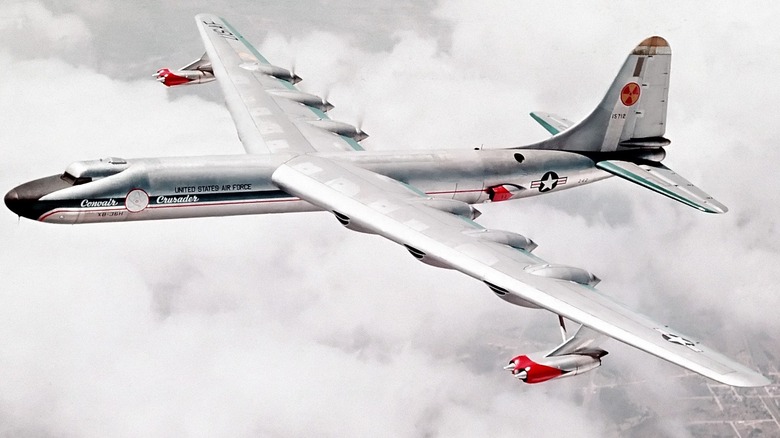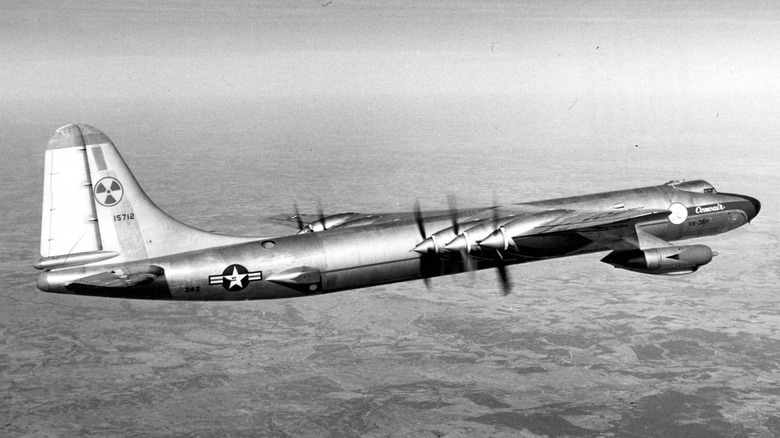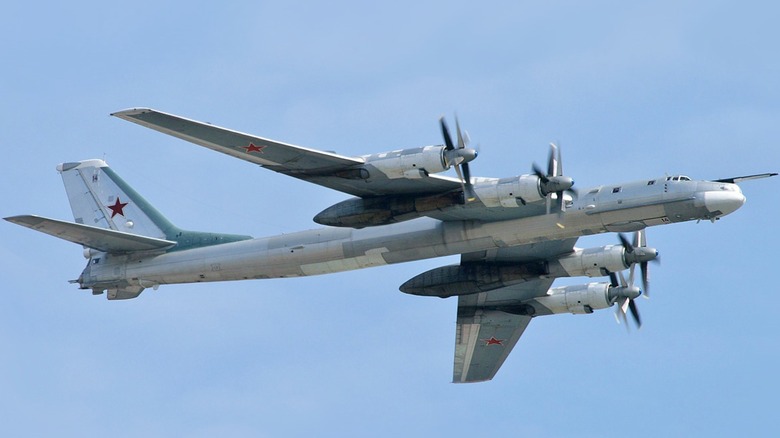Did The US Really Experiment With An Airplane That Used Nuclear-Powered Engines?
If you've ever played a "Fallout" game or watched the Amazon Prime series, you know what a world looks like when technology fully embraces the nuclear age. In "Fallout," everything from mechanized armor to cars and airplanes eschews traditional means of power, opting for nuclear reactors instead. It's a great way to supply near limitless energy, albeit only in fiction. However, a nuclear airplane nearly became a reality in the 1950s, thanks to a U.S. plan to outfit a strategic bomber with a nuclear reactor.
The bomber selected for the project was the massive Convair B-36 Peacemaker, renamed the NB-36H Crusader for the test. The idea was to evaluate the feasibility of using a nuclear reactor for a plane's propulsion system. However, the reactor on the Crusader wasn't hooked up to anything and was there only to test the system's shielding. After all, it wouldn't serve the U.S. Air Force well to kill an entire crew via acute radiation syndrome just to keep a strategic bomber in the air for longer.
The project fell under the Aircraft Nuclear Propulsion (ANP) program, and for the most part, it worked as intended. The plane flew with the installed reactor, accomplishing nearly 50 test flights before the Air Force canceled the program. The radiation exposure was deemed safe for the crew, but the potential for radioactive contamination from an accident was too great to overlook. Ultimately, the Air Force abandoned the ANP and focused on designing a new strategic heavy jet bomber.
The Air Force's NB-36H Crusader flew 215 hours with a nuclear reactor onboard
A lot of work went into converting a B-36 into the NB-36H nuclear variant, including replacing the crew and avionics cabins with an 11-ton station insulated by lead and rubber. This protected the crew from radiation that could potentially leak from the 1-megawatt air-cooled reactor. It weighed nearly 18 tons and was loaded into the aircraft's bomb bay. When the plane wasn't performing test flights, ground crews unloaded the reactor and stored it separately from the plane.
The nuclear reactor-carrying bomber conducted its first flight on September 17, 1955. It made an additional 46 flights, amounting to around 215 hours of operation. During that time, the reactor was operational for 89 hours. The tests were successful in that they proved an aircraft could be properly insulated from radiation leaks, ensuring the crew's survivability. Not everyone was on board with the project, with visionaries and highly influential scientists such as Dr. J. Robert Oppenheimer criticising the project's goals.
The physics worked, and the experiment was a success, but Dr. Oppenheimer was probably right in his thinking. While the crew was safe enough onboard the NB-36H, a plane crash could prove to be a deadly environmental disaster. Still, the concept was appealing to the Air Force, as it offered an opportunity to power its aircraft relatively cheaply and for longer periods. Unfortunately, the risks outweighed the rewards, and the project was abandoned, though it wasn't the only such project during the mid-20th century.
Other nations also experimented with nuclear-powered aircraft
While the U.S. Air Force's NB-36H Crusader was the first aircraft to take off with a nuclear reactor onboard, it was never technically a nuclear-powered aircraft. The project was abandoned before any such testing could occur, but other nations had similar ideas. The Soviet Union spent much of the 1950s and '60s designing and testing aircraft that could carry nuclear reactors. One such plane was the Tupolev Tu-95LAL, where LAL stands for "Letayushchaya Atomnaya Laboratoriya" (Flying Atomic Laboratory).
The Soviets took one of their massive turboprop bombers, the Tu-95, and converted it similarly to the United States and its NB-36H Crusader. The goal was to create a strategic bomber with unlimited range, capable of dropping a payload on the U.S. without having to refuel. Tests were conducted using the Tu-95 and several other aircraft, but like the Americans, nuclear-powered bombers were seen as being unnecessary and potentially dangerous due to accidents. The full nature of the tests and their results aren't known in the West, but it's clear the Soviets worked hard to try and make a nuclear-powered bomber work.
The Russian Federation hasn't given up on the concept, and is believed to be developing a nuclear-armed and nuclear-powered cruise missile. The 9M730 Burevestnik (NATO reporting name: SSC-X-9 Skyfall) is potentially powered by an isotope power source outfitted alongside a liquid-fueled rocket engine. The main benefit of a nuclear-powered cruise missile is its theoretically unlimited range, ensuring that the 9M730 could strike targets anywhere in the world.


